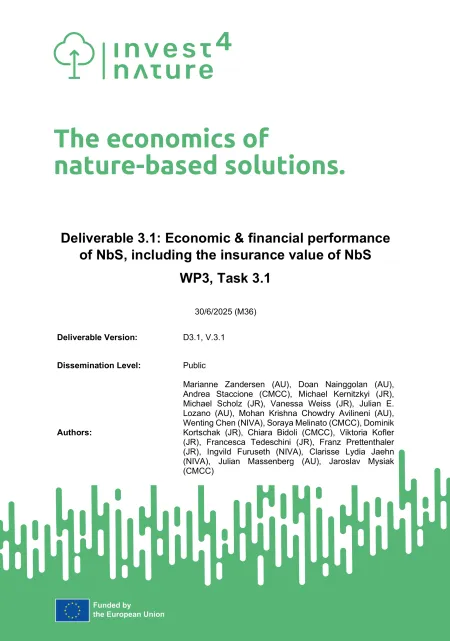
Resource description:
This report explores the economic and financial performance of nature-based solutions (NbS), with a particular emphasis on their insurance value, an emerging yet underutilised concept in NbS investment and decision-making. Developed within the Invest4Nature project, the report aims to improve the understanding of NbS as both financial risk management tools and key approaches to improving socio-ecological resilience in relation to health and wellbeing, pollution of air, soil and water, extreme events and socio-economic stability.
NbS are actions that protect, restore, and sustainably manage natural and modified ecosystems to address societal challenges. Despite their broad benefits, including climate adaptation and mitigation, biodiversity enhancement, and disaster risk reduction, NbS are significantly underfunded. A clearer articulation of their economic and financial returns and the inclusion of the multi-faceted insurance values of NbS is needed to mobilise investments at scale.
The report is based on two core components – a systematic literature review on the economic and financial performance of NbS and in-depth case analysis of two large-scale NbS implementations focusing on the insurance value.
The systematic review synthesises findings from 381 European studies assessing the economic performance of NbS across six landscape types:
- urban
- water management
- coastal/marine
- agriculture
- forests
- mountains.
The studies employ a range of valuation methods, with non-market benefit approaches the being most common.
Overall, NbS show promising economic returns, with median BCRs generally above one across all landscapes—especially high in urban and water-related interventions. However, results vary substantially depending on NbS typology, geographic context, and the scope of costs and benefits included.
Most studies focus on direct, monetisable impacts, with fewer capturing broader ecological or long-term benefits. Methodological gaps include inconsistent reporting of assumptions, limited treatment of uncertainty, and minimal integration of insurance-related or risk reduction values.
The case analyses apply advanced valuation methods to two implemented NbS to quantify their insurance value.
In Tirol, Austria, the restoration of the Lech River using floodplain rewilding and sediment control infrastructure was assessed through a Value-at-Risk (VaR) framework. The intervention reduced average annual flood damage to buildings by approximately €85,000 and lowered capital-at-risk in a 1-in-200-year event by €4.2 million at the local level, and €1.8 million at the regional (Tyrol-wide) scale. Additional analysis found a positive influence on local tourism, with indications of increased overnight stays attributed to improved landscape quality.
In Cascais, Portugal, the rewilding of the Ribeira das Vinhas river was evaluated using the avoided damage cost method. The restoration reduced expected flood-related damage to buildings by 43% and decreased the number of residents expected to be displaced in a major flood event by 60%. The number of slightly affected residents increased, showing a shift toward lower severity of exposure. A qualitative survey further confirmed perceived improvements in recreation, biodiversity, and climate regulation among local stakeholders. Together, the in-depth case results show that NbS can deliver quantifiable reductions in physical and financial risks while generating co-benefits that enhance ecological and social resilience.
Author/Contact:
Marianne Zandersen, Doan Nainggolan, Andrea Staccione, Michael Kernitzkyi, Michael Scholz, Vanessa Weiss, Julian E. Lozano, Mohan Krishna Chowdry Avilineni, Wenting Chen, Soraya Melinato, Dominik Kortschak, Chiara Bidoli, Viktoria Kofler, Francesca Tedeschini, Franz Prettenthaler, Ingvild Furuseth, Clarisse Lydia Jaehn, Julian Massenberg, Jaroslav Mysiak
Constraints:
- This version has been submitted to the European Commission / its Executive Agency and is currently under review.